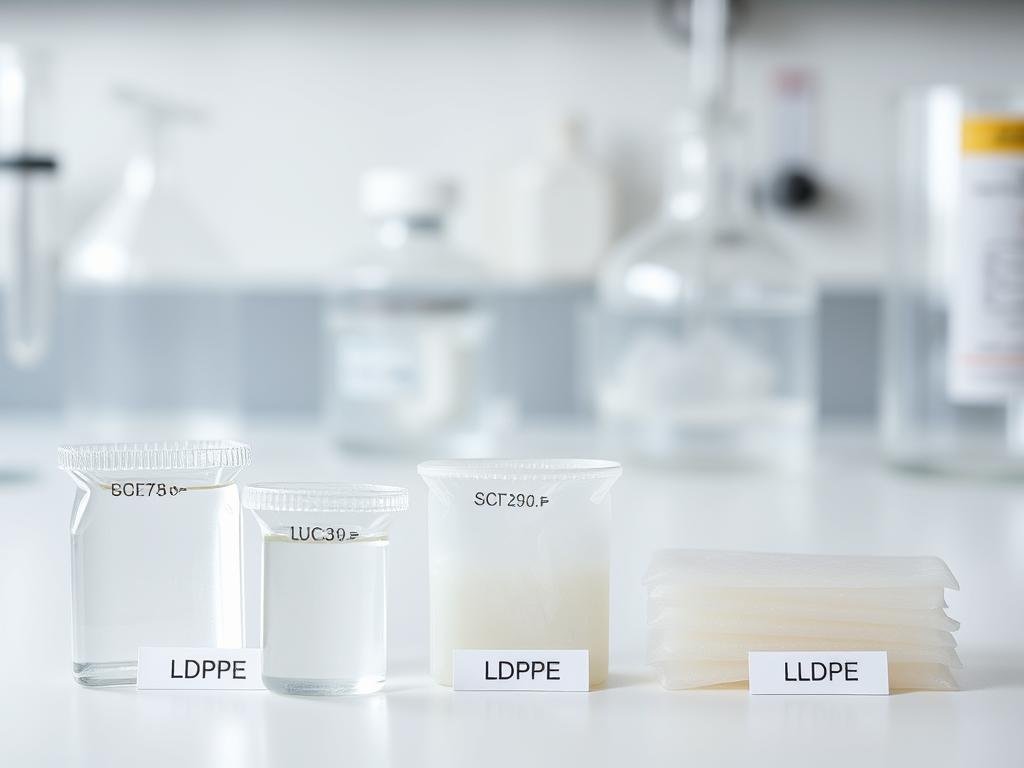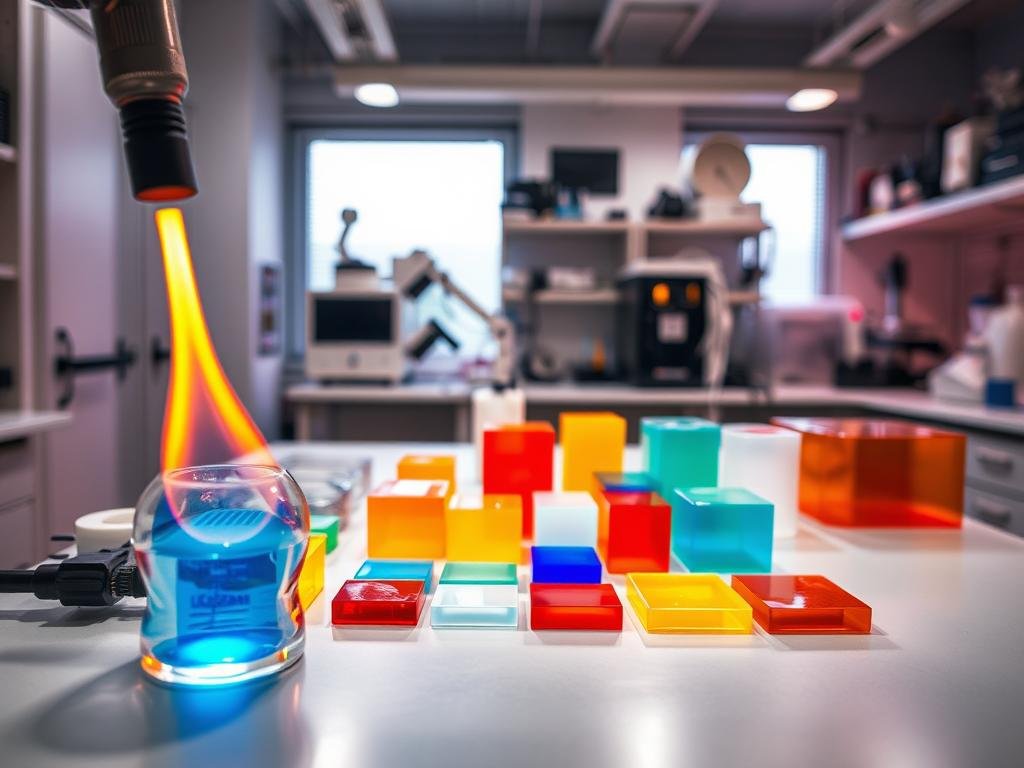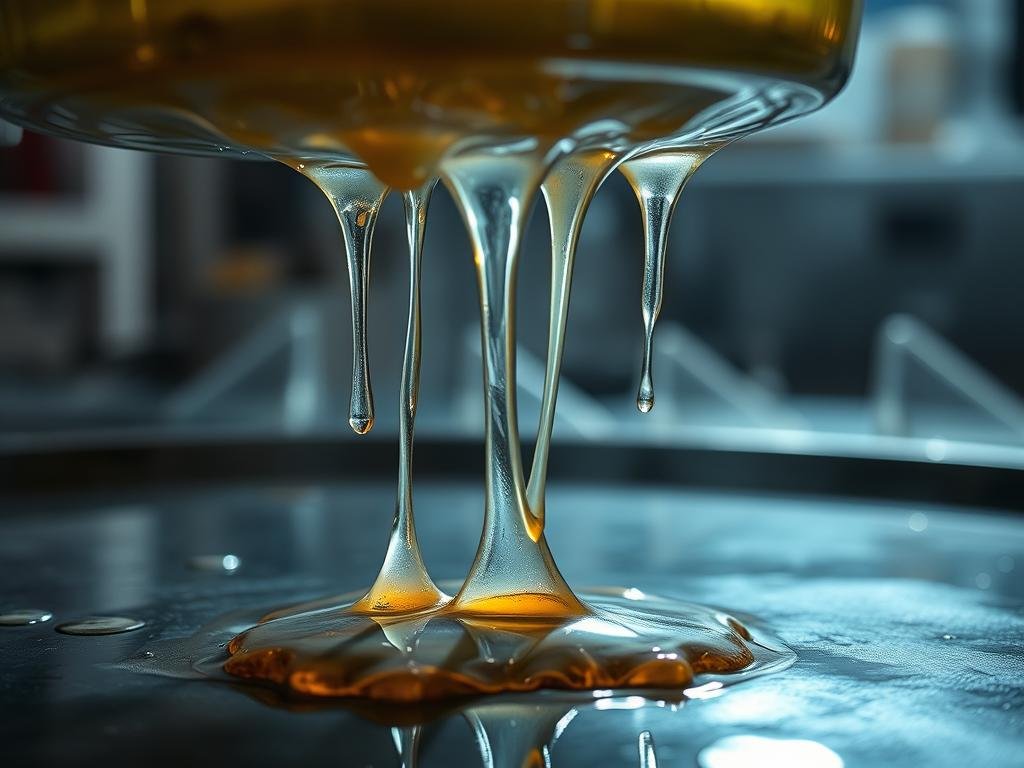Nearly 90% of manufactured polymer parts spend their first production hour above a crucial heat threshold, and that brief window defines fit, finish, and strength for millions of parts made each year.
Understanding melt temperature helps engineers pick suitable polymers and set correct molding parameters. In injection molding, true melt temperature is the heat measured at the nozzle as material exits, not just barrel setpoints. That value controls flow, cooling, and final surface quality.
Different polymers behave in distinct ways. Semi-crystalline grades like HDPE and Nylon show sharp transitions, while amorphous types such as PS soften more gradually. Typical ranges span about 105°C for LDPE up to roughly 240°C for processing-grade PS and higher for some nylons and PVC.
Rapidaccu brings over 15 years of CNC and manufacturing experience. We turn thermal data into repeatable results, lowering defects and speeding time to market. This guide will link thermal science to tooling, cycle time, and part performance so you can make smarter material choices for real applications.
Understanding the melting point of plastics in manufacturing today
Small shifts in processing temperature change flow, surface finish, and long-term performance for many resins. In molding practice, true melt temperature is a process result, not just a controller readout. Mechanical shear, residence time, and screw condition all add heat, so setpoints and measured melt can differ.
What “melting point” means for thermoplastics vs. how plastics actually soften
Some thermoplastics show a sharp transition from solid to liquid. Others soften gradually and behave more like thick syrup over a range. That behavior changes how material fills thin walls and captures fine detail in molds.
Why melting temperature matters for flow, cooling, and final part quality
Melt temperature controls viscosity, which affects gate fill, knit lines, and surface replication. Heat input also controls cooling time and warpage risk. Precise thermal control improves first-pass yield and reduces scrap.
- Viscosity control influences gate fill and knit-line strength.
- Shear plus heater power determine actual melt, not just barrel setpoints.
- Mold temperature sets crystallinity in semi-crystalline resins and relieves stress in amorphous ones.
- Consistent thermal discipline widens process windows and improves cosmetic quality.
| Aspect | Amorphous Resins (PC, ABS) | Semi-crystalline Resins (HDPE, Nylon) |
|---|---|---|
| Softening behavior | Gradual; reduced molded-in stress with higher mold temp | Sharp transition; crystallinity increases with mold temp |
| Key process lever | Mold temperature for stress relief | Mold temperature to control crystallinity and shrinkage |
| Production benefit | Better impact and fatigue resistance | Improved dimensional stability and wear resistance |
Rapidaccu’s precision approach links accurate thermal control to superior surface finish and tolerance outcomes in prototypes and mass production. Consistent melt and mold temperatures mean stable properties and repeatable quality on every run.
whats is the melting point of plastic: definitions, ranges, and key concepts
Temperature metrics guide material selection and process settings for reliable parts. Designers need clear definitions to pick the right limit for performance and machining. Rapidaccu recommends matching a temperature metric to how a part will be used and processed.
Melting point versus melt temperature in processing
Melting point plastic refers to the solid-to-liquid transition for crystalline resins. In production, melting temperature describes the actual polymer heat at the nozzle that governs flow and fill.
Barrel setpoints do not equal measured melt. Shear, residence time, and screw condition raise polymer temperature above controller values. Use melt temperature for process control and melt flow predictions.
Vicat softening temperature and heat deflection compared
Vicat marks when a material softens under a small load. HDT shows when it bends under a larger load without melting.
Both temperatures help designers avoid service failure. Use Vicat and HDT for parts that face sustained loads and heat rather than relying only on melting point plastic.
Crystalline versus amorphous structure and thermal behavior
Crystalline plastics like nylon have a defined point plastic and stay rigid until that transition. Amorphous types soften gradually and are best defined by Vicat or HDT.
Mold temperatures tune crystallinity in semi-crystalline resins, improving creep resistance, wear resistance, and dimensional stability. For amorphous resins, higher mold temperature reduces stress and boosts impact and fatigue performance.
- Differentiate melting point from melt temperature: use nozzle melt for processing control.
- Choose Vicat/HDT for service limits under load and heat.
- Match your metric to material structure to prevent premature deformation.
| Metric | Best used when | Design focus |
|---|---|---|
| Melting point | Crystalline materials, processing window | Flow and solidification |
| Vicat softening | Amorphous materials, slow heating | Softening under small load |
| HDT | Parts under sustained load | Deflection and load-bearing limits |
Common plastics and their melting point ranges with typical applications
Every resin family brings a characteristic thermal range that influences flow, cooling, and part performance.

Polyethylene (LDPE / HDPE)
LDPE melts near 105°C and HDPE around 125°C. These low temperatures give flexibility and low cost.
They suit packaging films, bags, and sheets where stretch and economy matter.
Polypropylene
PP processes near 165°C. That higher temperature helps parts resist hot liquids.
Common applications include mugs, tableware, lids, and food containers.
Polystyrene
Polystyrene shows a wide behavior range: some consumer items soften under 100°C, while processing melts can approach 240°C.
PS appears in disposable cutlery, foam, and protective packaging; heat sensitivity limits some uses.
Nylon / Polyamide and PVC
Nylon melts above 200°C and offers toughness for textiles, cable ties, and mechanical parts.
PVC processes near 210°C and appears in piping, wire insulation, and resilient flooring.
| Resin | Typical melt range | Common applications | Mold temperature (°C) |
|---|---|---|---|
| LDPE / HDPE | ~105°C / ~125°C | Packaging films, bags, sheets | 20–60 |
| Polypropylene | ~165°C | Mugs, lids, containers | 30–80 |
| Polystyrene | ~90–240°C (use-dependent) | Cutlery, foam, packaging | 30–60 |
| Nylon / PVC | ~200°C+ / ~210°C | Textiles, cable ties, piping, flooring | 40–90 / 40–70 |
Rapidaccu supports selecting and machining these common polymers for prototypes and production. Match resin temperature ranges to flow, cooling strategy, and desired surface finish for predictable results.
Engineering plastics and high melting point materials for demanding environments
Engineering resins push processing temperatures far above commodity ranges to deliver parts that endure heat, wear, and tight tolerances.
Polycarbonate processing and benefits
Polycarbonate processes near 280–320°C. Higher mold temperatures (85–120°C) reduce internal stress and boost impact resistance and clarity.
That combination yields thin, transparent parts with excellent strength and surface finish when controlled precisely during molding.
PEEK for extreme performance
PEEK runs around 350–390°C with mold temps at 120–160°C. It delivers creep resistance and thermal stability needed in aerospace and medical uses.
Balancing heat, stability, and cost
- High melting materials give superior heat resistance and dimensional control versus commodity resins.
- They demand more energy, hardened tooling, and tight process control.
- Nylon variants offer wear and fatigue resistance when ultra-high temperatures are not required.
| Material | Processing °C | Mold °C | Typical benefit |
|---|---|---|---|
| Polycarbonate | 280–320 | 85–120 | Impact resistance, clarity |
| PEEK | 350–390 | 120–160 | High-temperature stability |
| Nylon | 200–260 | 60–120 | Wear and fatigue resistance |
Rapidaccu machines PC and PEEK with tight tolerances. We tune process parameters to protect properties and deliver exceptional surface finish for high-performance applications.
Melt temperature vs. mold temperature: dialing in strength, stability, and cycle time
Balancing nozzle heat and cavity temperature changes how a part forms and how long cooling takes. Rapidaccu tunes both to meet targeted mechanical and cycle goals across production runs.
Why lower melt plus higher mold temperature often improves properties
Using a slightly lower melt with a warmer mold reduces thermal gradients. That lowers internal stress and improves impact and fatigue resistance in amorphous resins.
Effects on crystallinity, impact, creep, wear, and stress cracking
In semi-crystalline materials, higher cavity temperature promotes larger, more uniform crystals. This boosts creep and wear resistance and increases dimensional stability at elevated service temperatures.
- Reduced melt temperature cuts shear degradation and limits resin breakdown.
- Higher mold temperature raises surface finish and reduces stress-crack susceptibility.
- Combined strategy often shortens cooling time by avoiding overly hot melt that slows solidification.
Risks of excessive melt temperature and practical setpoint habits
Pushing melt too high accelerates chemical breakdown, increases cycle energy, and lengthens cooling. That damages part consistency and raises scrap rates.
| Control | Benefit | Operator habit |
|---|---|---|
| Lower melt | Less resin degradation, consistent viscosity | Monitor nozzle melt, not only barrel setpoints |
| Higher mold | Better impact, dimensional stability, and crystallinity | Use steady cavity control and validate with short runs |
| Balanced approach | Shorter cycles and repeatable properties | Log melt and mold temps; avoid “button-pushing” |
For more guidance on matching thermal strategy to material behavior, see our process temperature chart. Rapidaccu’s approach ties melt and mold settings to repeatable performance on every job.
Material selection: matching melting points to application, process, and performance
Good material choices begin by mapping expected heat exposure to process capability and end-use demands.
Start with criteria: how much heat a part sees in service, required mechanical strength, chemical resistance, and cost limits. Match those needs to candidate resins before tooling begins.
Process fit matters. Confirm that injection equipment can reach required melt and cavity temps and that cooling circuits remove heat fast enough for repeatable cycle times.

Real-world kettle example
Polypropylene melts near 160–165°C, so a kettle holding boiling water at 100°C stays stable in normal use. That gap gives thermal stability and predictable performance.
Mixing different resins or recycled streams widens processing ranges and can lower strength. For critical parts, avoid blended feeds unless validated by manufacturers.
- Align resin thermal ranges with in-service heat exposure and strength needs.
- Verify equipment can reach and control required temperatures and cooling rates.
- Prefer single-grade feedstock for consistent performance; test recycled mixes carefully.
- Engage manufacturers early to balance properties, cycle time, and tooling cost.
| Decision factor | What to check | Outcome |
|---|---|---|
| Heat exposure | Service temperature vs. resin capability | Choose resin that stays stable under use |
| Process fit | Machine temp range and cooling capacity | Repeatable cycles and consistent parts |
| Material feed | Virgin vs. recycled or blended | Predictable strength and narrow processing window |
For practical guidance on matching melt and mold settings to materials, see our melt temperature guidance. Rapidaccu helps teams pick material and process targets that meet budget and performance goals.
Manufacturing quality implications: from injection molding to CNC machining
Thermal history from molding to finishing dictates dimensional accuracy and surface quality. Control during injection and cavity cooling sets crystallinity and residual stress that later affect machining and final product.
Dimensional stability, surface finish, and tolerance control at temperature
Higher mold temperatures reduce molded-in stress in amorphous resins and improve impact and fatigue performance. For semi-crystalline materials, cavity heat tunes crystal size and improves creep and wear resistance.
Consistent melt and mold records yield predictable properties. That predictability simplifies tight-tolerance secondary work and reduces rework in production.
How Rapidaccu optimizes plastics machining based on melt and softening behavior
Rapidaccu leverages 15+ years in CNC plastic and metal machining to set feeds, speeds, and fixturing that account for residual stress from molding. We align molding conditions to target crystallinity for easier machining and better surface finish.
- Link processing temperatures to dimensional stability during molding and machining.
- Use consistent thermal histories to achieve repeatable tolerances.
- Adjust machining parameters for softened regions to protect part quality.
| Stage | Key control | Effect on product | Benefit |
|---|---|---|---|
| Injection | Melt and nozzle temp | Viscosity, flow | Consistent cavities |
| Mold | Cavity temp | Crystallinity, stress | Dimensional stability |
| Machining | Feeds, fixturing | Surface finish, tolerance | Reduced rework |
Rapidaccu expertise: from prototype to mass production with precision plastics
A clear thermal strategy prevents surprises when you scale a part from a single prototype to thousands of pieces. Rapidaccu pairs shop-floor discipline with design guidance to keep parts accurate and repeatable through every stage.
15+ years in CNC plastic and metal machining: accuracy, finish, and repeatability
Our team delivers precision CNC plastic and metal machining backed by more than 15 years of experience. We focus on tight tolerances, premium surface finish, and consistent runs for both low-volume prototypes and high-volume production.
Guidance on picking materials with the right melting points for your application
We advise manufacturers on material selection and process windows. Engineering resins like polycarbonate benefit from warmer cavity temps for impact and stress-crack resistance. Nylon offers higher thermal limits for mechanically demanding parts.
Where appropriate, we recommend a lower melt temperature combined with a higher mold temperature to improve final strength and shorten cycles. That tactic succeeds only when resin limits and tooling are respected.
- Track record producing accurate, repeatable parts across plastics and metals.
- Interpret plastic melting ranges and processing windows to meet application targets.
- Advise on PC, PA/nylon, PEEK, and commodity resins by required strength and environment.
- Mitigate risk by dialing melt and mold settings to protect properties and speed time to market.
- Engage us early to align materials, tooling, and process for cost-effective manufacturability.
| Stage | What we control | Benefit |
|---|---|---|
| Prototype | Melt, mold temp, feeds | Validate fit, finish, and function |
| Pre-production | Process windows, tooling adjustments | Stable cycles and lower scrap |
| Volume | Process monitoring, QC | Repeatable supply for manufacturers |
Conclusion
Clear temperature control turns material data into reliable parts that meet tolerance and finish targets.
Understand nozzle melt versus barrel setpoints, and use cavity heat to tune strength and dimensional stability. Avoid excessive melt temperatures to limit degradation and long cycles.
Common resins span a wide processing range: LDPE ~105°C, HDPE ~125°C, PP ~165°C, PS soft near 90°C and processes higher, Nylon ~200°C+, PVC ~210°C, PC ~280–320°C, PEEK ~350–390°C. Match resin heat behavior to cycle timing and tooling needs for predictable results.
Data‑driven control of melt and mold temperatures unlocks better resistance and in‑service performance. Rapidaccu will translate those choices into high‑quality parts from prototype through mass production with precise finish and repeatability.

